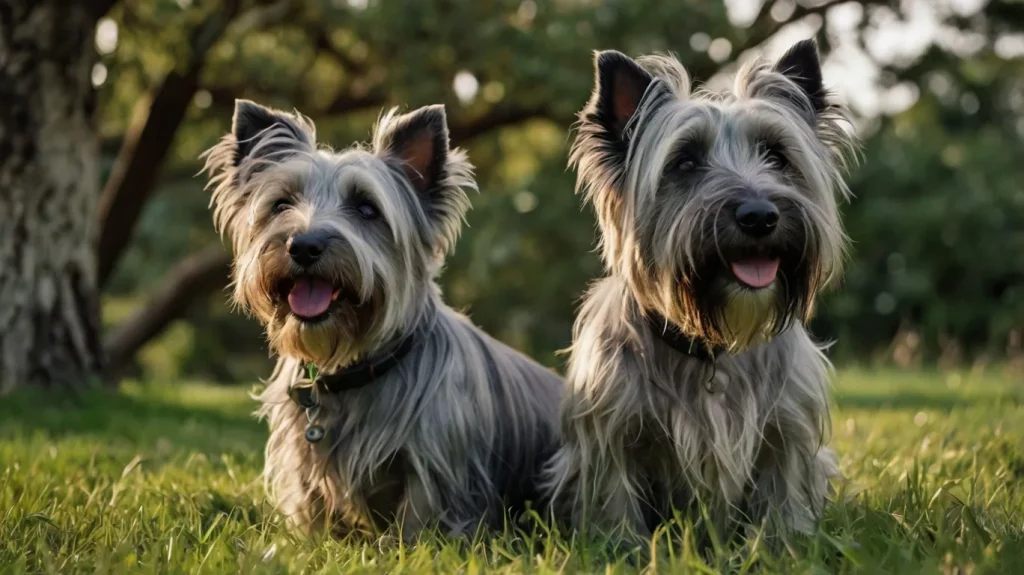The Skye Terrier, with its distinctive elegance and storied past, embodies a unique blend of charm and courage. Originally bred in the remote Isle of Skye in Scotland, this breed has been a beloved companion of nobility and commoner alike, captivating hearts with its fearless and affectionate demeanor.
As we delve into the characteristics that define the Skye Terrier, from their silky, floor-length coat to their steadfast loyalty, we uncover the layers of this breed’s rich heritage.
This article promises to provide a thorough exploration of their history, highlighting how they’ve evolved from fierce hunters to cherished household pets.
Understanding the health and well-being of the Skye Terrier is crucial for any prospective or current owner.
These dogs, known for their robust constitution, still require specific care to address potential breed-specific health challenges.
By discussing key health concerns, from common conditions to preventative measures, we aim to equip you with the knowledge needed to ensure a healthy, fulfilling life for your Skye Terrier.
Through this guide, we’ll also share practical tips on grooming, diet, and exercise that honor the breed’s needs, ensuring that your Skye Terrier thrives in both body and spirit.
1. Skye Terrier History
The Roots on the Isle of Skye
The Skye Terrier’s history begins in the 16th century on the Isle of Skye, one of Scotland’s rugged Inner Hebrides islands. Originally bred to hunt foxes and badgers, these dogs were valued for their tenacity and courage.
The breed’s long, dense coat provided protection against the harsh Scottish weather and rough terrain, making them particularly well-suited for hunting in their native landscape.
Royal Influence and Popularity
The breed gained prominence beyond the Scottish isles thanks to an association with British royalty. Queen Victoria, known for her love of dogs, kept Skye Terriers in the 19th century, which significantly boosted their popularity among the aristocracy and elevated the breed’s status across Europe.
Historical Milestones
Show Ring Success
In the late 19th century, the Skye Terrier was among the earliest breeds to be shown in dog shows, and they quickly gained fame for their striking appearance and poised demeanor.
The breed’s standard was established during this period, which helped to solidify their presence in the show ring and maintain breed standards.
The Tale of Greyfriars Bobby
Perhaps the most heartwarming story in the Skye Terrier’s history is that of Greyfriars Bobby, a dog who reportedly guarded his master’s grave for 14 years until his own death in 1872.
This tale of loyalty and devotion brought international attention to the breed and remains a beloved legend in Scotland.
Notable Figures and Contributions
Queen Victoria’s Impact
Queen Victoria’s affection for the Skye Terrier did more than popularize the breed; it also influenced breeding practices and public perceptions of dogs as companion animals.
Her involvement is often credited with initiating the transformation of the Skye Terrier from a working-class hunter to a fashionable pet among Victorian England’s elite.
Contributions to Modern Breeds
Skye Terriers also played a role in the development of other terrier breeds.
Their genetic traits have been interwoven with various other terriers to enhance characteristics such as coat quality and temperament, showcasing their influence beyond their own breed line.
2. Characteristics of the Skye Terrier
The Skye Terrier displays loyalty and affection within its family unit but tends to be reserved around strangers, a trait that should not be mistaken for timidity as these dogs are inherently confident and somewhat self-focused. This breed shares the typical terrier traits of independence and strong will, often choosing to act on its own impulses. Skye Terriers generally have assertive personalities, and although they can coexist with other dogs if raised together from a young age, they usually thrive as the sole pet in a household. Their tenacious nature may not be for everyone, but for an owner who understands and appreciates their idiosyncrasies, a Skye Terrier can become an immensely loyal and cherished member of the family.
3. Sky Terrier Care
Caring for a Skye Terrier involves a manageable exercise regimen, yet their self-reliant demeanor and lengthy fur demand considerable training and regular grooming. Owners should anticipate the need for consistent obedience training and frequent grooming sessions to maintain the health and appearance of their coat.
Exercise
Despite their athletic build, Skye Terriers are relatively low-energy dogs that do not need intensive exercise to stay healthy. A total of about 30 minutes of walking each day, split into one or two walks, along with some quality playtime with their owners, is usually enough to keep them content and fit. Skye Terriers take pleasure in playful activities and some even shine in canine sports such as agility. Additionally, like many terriers, they have a natural inclination to dig. Providing a designated sandbox in the yard can be a great way for them to satisfy this instinct safely and stay engaged.
Grooming
The Skye Terrier’s elegant feathered coat demands consistent care to prevent knots and mats. Frequent brushing and combing are necessary, and any tangles that do occur should be gently eased apart using a detangling spray. Regular grooming routines such as teeth brushing, nail clipping, and ear cleaning are also essential.
Particularly, the fur around the ears requires careful attention to avoid buildup of wax and prevent infections, as recommended by a veterinarian. Bathing should occur monthly, or less often during colder months, taking care not to agitate the fur, which can lead to matting.
Training
Training a Skye Terrier requires patience and understanding, as their independent streak—likely a mix of their noble heritage and classic terrier traits—can make them a bit headstrong. While they have a friendly disposition, they are also determined, which means they respond best to gentle, positive reinforcement. Starting basic training early, around eight weeks of age, is crucial to setting good behavioral foundations. Harsh words or negative reinforcement will not yield results with these sensitive and reserved dogs; instead, focus on encouragement and rewards to bring out their best. While more advanced training may be challenging, consistent effort and a positive approach can make a significant difference in shaping their behavior.
4. Common Health Problems
Skye Terriers are typically robust and healthy, but their unique build—muscular and low to the ground—can make them susceptible to certain orthopedic issues. Additionally, some Skye Terriers may be predisposed to specific types of cancer, though this is not a universal concern across the breed. With proper care and regular veterinary check-ups, many Skye Terriers live healthy, active lives.
The following are conditions for Skye Terrier owners to be aware of:
- Disc diseases: Skye Terriers are at risk for neck and back injuries, often linked to disc disease. To minimize this risk, it’s essential to avoid allowing them to engage in rough play or jump from elevated surfaces. Carrying your Skye Terrier up and down stairs can also help prevent strain or injury. When walking, opt for a harness instead of a collar to reduce pressure on their neck and spine. Additionally, maintaining a healthy weight is crucial, as extra pounds can increase the likelihood of back problems. These preventive measures can go a long way in ensuring your Skye Terrier remains active and injury-free.
- Cancer: Regular health monitoring is essential for Skye Terriers, as they may be susceptible to certain cancers such as mammary cancer and hemangiosarcoma. Early detection through routine check-ups can help address potential issues and ensure timely treatment if needed.
5. Diet and Nutrition
Skye Terriers have similar nutritional requirements to most dogs, thriving on a high-quality, protein-rich diet. Tailor their meals to meet specific needs, such as those of a growing puppy, a senior dog, or one with food sensitivities. Healthy treats can be a great addition, especially since Skye Terriers respond well to positive reinforcement during training. However, monitor their weight carefully, and if you notice any excess weight gain, consult your veterinarian. Your vet can help create a customized meal and portion plan based on your Skye Terrier’s age, weight, and activity level, ensuring they remain healthy and energized.
6. Where to Adopt or Buy a Skye Terrier
To start your search, check out these resources for the national breed club, rescues, and the AKC:
- Skye Terrier Club of America
- AKC Skye Terrier Breeders
- Skye Terrier Club of America Rescue Information
7. Skye Terrier Overview
Pros
- Excellent companion for the right owner
- Great for apartment living
- Unique personality and appearance
Cons
- Can be stubborn and resist training
- Not fond of cats, other dogs, or small children
- Tendency to bark and dig
More Dog Breeds and Further Research
If you love the Skye Terrier, you may also like these similar breeds:
8. FAQ
Skye Terriers, like many terrier breeds, have a reputation for being quite vocal. While there are strategies to reduce excessive barking, such as consistent training and positive reinforcement, prospective owners should be ready for a breed that naturally enjoys expressing itself. Their independent streak can make training a challenge, so patience and persistence are key.
2. Are Skye Terriers Good Pets?
Skye Terriers are incredibly loving and loyal to their families, forming strong bonds with those closest to them. However, they tend to be reserved with strangers and may display dominance toward other animals, even with proper socialization. For an owner who understands their unique temperament, the Skye Terrier proves to be a deeply devoted and rewarding companion.
3. Do Skye Terriers Shed?
Skye Terriers shed less than most long-haired breeds, but they can still leave a moderate amount of fur behind. Regular brushing is essential to minimize shedding and keep their coat in top condition, helping to reduce loose hair around the home.

Dr. Emily Harper is a California-based veterinarian specializing in terrier breeds. With years of experience in veterinary medicine and a passion for terrier care, she focuses on breed-specific health, grooming, and behavior.
Emily’s journey began with a love for dogs, leading her to pursue a career in veterinary medicine and develop expertise in terriers. She has authored numerous articles on terrier health and grooming and educates pet owners on providing the best care for their companions.
In her free time, Dr. Harper enjoys hiking California’s trails with her rescue terriers, Max and Bella, and spending time with her family.


